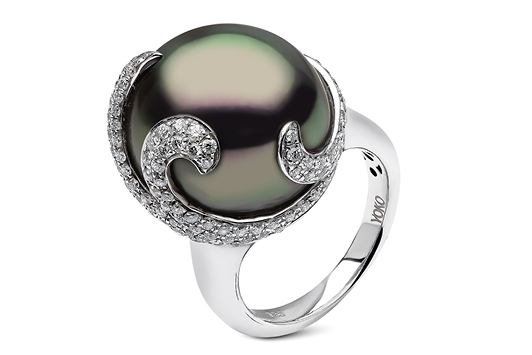 Image: Yoko London
Image: Yoko London
For centuries, natural pearls were cherished baubles for the highborn few, but the process of pearl cultivation — perfected over a century ago — expanded their affordability and gave dedicated pearl farmers a say in producing certain shapes and colors. Today, the classic, demure strand of creamy-colored orbs is taking a back seat to more extraordinary shades and shapes in the hands of jewelry artists.
Cultured-pearl strands, especially the sumptuous South Sea variety or the winsomely shaped freshwater types, are still highly collectible, and their impressive features add panache to any ensemble. But experimental jewelers are not relying solely on strands today; they also focus on attractive single pearls.
For specimens that have imperfections in their nacre, Fred Sagues — CEO and owner of
Black Market Pearls, Tahiti — offers an imaginative solution: the company’s Diamond Pearls line. “The idea is that some beautiful pearls with marks are unsuitable for high-end jewelry. So we set diamonds in those spots, creating added value.”
Pearls can communicate with jewelry clients. “When we use cultured pearls in unusual ways, our customers always take notice, and if a piece speaks to them, it usually finds a new forever home,” says designer Gregore Morin of
Gregore & Jennifer-Rabe. While some of Morin’s customers are knowledgeable about the intricacies of the pearl industry, he finds that “most just enjoy them.”
Farmer’s market
High demand has pushed farmers to up their game and produce superior pearls for a discerning clientele. “Regarding Tahitian and South Sea pearls, farming techniques and the farmers themselves are getting better at delivering pearls of higher quality,” says Sagues.
Each of a farm’s lagoons has its own ecosystem, he explains, and may yield different hue overtones. Water temperature, nutrients, oyster population density, and general oyster health all factor into better pearl production. “But you can’t rush a good thing,” he emphasizes. “South Sea farmed pearls need a minimum of 16 to 18 months’ immersion time to get a good layer of nacre.”
Treatments are routine in cultured-pearl production, especially at large factories in Japan and China that process great quantities. The goal is to provide a uniform appearance for matched pearl strands, and as long as there’s appropriate disclosure, these procedures are industry-accepted and have no negative effect on the pearls’ value. Pre-treatment washing is standard, as are the bleaching, dyeing and light polishing that often follow. Some pearl types also undergo luster enhancement, which tightens the nacre layers.
Who’s buying
While Western consumers have long been keen on cultured pearls, there’s another important market to watch, according to Betty Sue King, owner of pearl wholesaler King’s Ransom. “The rise of China’s domestic buying power has changed the distribution and pricing of pearls. Chinese cultured pearls are in great demand, being sold domestically through retail and online with great profit margins. Quality South Sea, Tahitian, [and] Japanese Akoya — [as well as the lower qualities that make up] the bulk of pearl cultivation — are eventually exported to China, which is the biggest market for all pearls.”
A large portion of this trade has traditionally gone through Hong Kong, but with the bad press the municipality has had lately and its difficulties with Chinese rule, Sagues believes the market may switch back to the birthplace of the cultured pearl: Japan. “The Japanese have a more traditional and refined approach to the pearl and jewelry trade, and this will keep prices at a good level.”
Meanwhile, the call for sustainably sourced and organic products is growing among eco-conscious consumers, he notes. “Tahitian pearls fit right into this market sector. I don’t see the prices of higher-grade pearls going down.”
A good strand is hard to find
Demand for quality cultured specimens has made acquisitions tough on high-end jewelers, according to Michael Hakimian, CEO of jeweler
Yoko London. Still, he affirms, “we rise to the challenge and never compromise on quality.” The company’s nearly 50 years in the pearl industry have helped it establish close working relationships with farmers.
As with other industries reliant on global trade, Covid-19 has had a profound effect on pearl cultivation worldwide, King reports. “Wholesale dealers in Hong Kong have had difficulty obtaining [goods due to] Covid-19 restrictions. Travel lockdowns, both domestic and international, have hindered production. Consequently, it has limited current and future production, since pearls take two to four years to cultivate. [This] is universally the case for China, Australia, Indonesia, the Philippines, Japan and Tahiti.”
When the pandemic hobbled walk-in traffic, Yoko London pivoted to acquire an in-house photographer and videographer. The high-quality imagery let shoppers see product images across multiple channels, including Instagram, the company’s website and those of retail partners.
“Since the pandemic, we’ve experienced a huge demand for easy-to-wear, fashion-forward, everyday pieces like our Trend and Sleek collections, [which feature] lustrous freshwater and Akoya pearls in smaller sizes [that are] lightweight and comfortable to wear from day to night. Our Blush versions of key pieces feature natural-color pink freshwater pearls,” says Hakimian.
For Morin, an appreciation of nature is the driving force behind his work with these nacreous gems. “And just when I think I have a clever idea, I remind myself that nature created it all before, and I am just rediscovering it.”
Article from the Rapaport Magazine - June 2022. To subscribe click here.